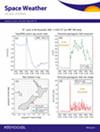Influence of Tectonic and Geological Structure on GIC in Southern South Island, New Zealand
IF 3.7
2区 地球科学
引用次数: 0
Abstract
As part of a 5-year project to assess the risk posed by geomagnetically induced currents (GIC) to the New Zealand electrical transmission network, long-period magnetotelluric (MT) measurements have been made at 62 sites in southern South Island of New Zealand, a region where there was an absence of previous MT data. The data are largely 3-dimensional in character, but show distinct features that can be related to the known tectonic and geological structure. In this work we focus on how the measured MT impedance tensors, and a simple interpretation of conductivity structure, can be used to assess the influence of tectonic and geological structure on GIC. We use the impedance tensors to calculate the magnitudes and orientations of induced electric fields in response to various orientations of inducing magnetic field. The electric fields so calculated are then used in a simplified model of the transmission network to calculate GIC at grounded substations. Our results confirm that tectonic/geological structure in the lower South Island and the resulting electrical conductivity variations have important impacts on the GIC magnitude. In the south-west, smaller induced electric fields, associated with the higher conductivity in that region, lead to much reduced GIC at a substation in that area. In contrast, higher electric fields occurring in a NW-SE band across the center of the region, contribute to much larger GIC in Dunedin city. Our results thus help explain the observed GIC reported at transformers in the region.构造和地质构造对新西兰南岛南部GIC的影响
作为评估地磁感应电流(GIC)对新西兰输电网络构成风险的5年项目的一部分,在新西兰南岛南部的62个地点进行了长周期大地电磁(MT)测量,该地区以前没有MT数据。这些数据在很大程度上是三维的,但显示出与已知的构造和地质结构有关的明显特征。在这项工作中,我们的重点是如何测量大地电磁学阻抗张量,以及电导率结构的简单解释,可以用来评估构造和地质构造对大地电磁学的影响。我们利用阻抗张量来计算感应电场的大小和方向,以响应感应磁场的不同方向。然后将计算得到的电场用在输电网络的简化模型中,以计算接地变电站的GIC。我们的研究结果证实,南岛下部的构造/地质构造和由此产生的电导率变化对GIC震级有重要影响。在西南地区,较小的感应电场与该地区较高的导电性有关,导致该地区变电站的GIC大大减少。相反,在横跨区域中心的NW-SE波段出现的较高电场,导致达尼丁市的GIC大得多。因此,我们的研究结果有助于解释该地区变压器中观察到的GIC。
本文章由计算机程序翻译,如有差异,请以英文原文为准。
求助全文
约1分钟内获得全文
求助全文

 求助内容:
求助内容: 应助结果提醒方式:
应助结果提醒方式:


